
Huntsman spiders, members of the family Sparassidae, are known by this name because of their speed and mode of hunting. They are also called giant crab spiders because of their size and appearance. Larger species sometimes are referred to as wood spiders, because of their preference for woody places. In southern Africa the genus Palystes are known as rain spiders or lizard-eating spiders. Commonly, they are confused with baboon spiders from the Mygalomorphae infraorder, which are not closely related.

The Araneomorphae are an infraorder of spiders. They are distinguishable by chelicerae (fangs) that point diagonally forward and cross in a pinching action, in contrast to the Mygalomorphae, where they point straight down. Araneomorphs comprise the vast majority of living spiders.
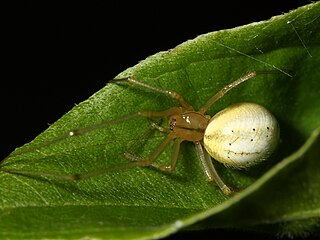
Theridiidae, also known as the tangle-web spiders, cobweb spiders and comb-footed spiders, is a large family of araneomorph spiders first described by Carl Jakob Sundevall in 1833. This diverse, globally distributed family includes over 3,000 species in 124 genera, and is the most common arthropod found in human dwellings throughout the world.
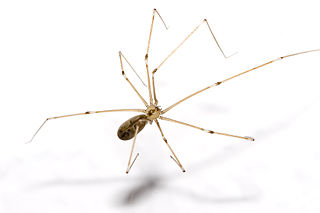
The Pholcidae are a family of araneomorph spiders. The family contains more than 1,800 individual species of pholcids, including those commonly known as cellar spider, daddy long-legs spider, carpenter spider, daddy long-legger, vibrating spider, gyrating spider, long daddy, and skull spider. The family, first described by Carl Ludwig Koch in 1850, is divided into 94 genera.

Crevice weaver spiders (Filistatidae) comprise cribellate spiders with features that have been regarded as "primitive" for araneomorph spiders. They are weavers of funnel or tube webs. The family contains 18 genera and more than 120 described species worldwide.

Pregabalin, sold under the brand name Lyrica among others, is an anticonvulsant, analgesic, and anxiolytic medication used to treat epilepsy, neuropathic pain, fibromyalgia, restless leg syndrome, opioid withdrawal, and generalized anxiety disorder (GAD). Pregabalin also has antiallodynic properties. Its use in epilepsy is as an add-on therapy for partial seizures. It is a gabapentinoid medication and acts by inhibiting certain calcium channels. When used before surgery, it reduces pain but results in greater sedation and visual disturbances. It is taken by mouth.

Psechridae is a family of araneomorph spiders with about 70 species in two genera. These are among the biggest cribellate spiders with body lengths up to 2 centimetres (0.79 in) and funnel webs more than 1 metre in diameter.

Alireza Zamani is an Iranian arachnologist and taxonomist.
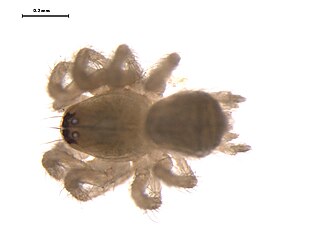
Neoantistea is a genus of dwarf sheet spiders that was first described by Willis J. Gertsch in 1934.

Poeciloneta is a genus of sheet weavers that was first described by C. Chyzer & Władysław Kulczyński in 1894.

Yunohamella is a genus of comb-footed spiders that was first described by H. Yoshida in 2007.
Poeciloneta lyrica is a species of sheetweb spider in the family Linyphiidae. It is found in North America.
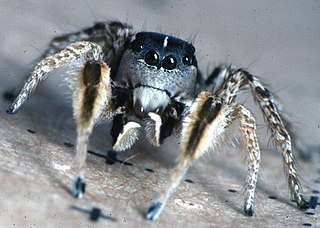
Habronattus tarsalis is a species of jumping spider in the family Salticidae. It is found in the United States and has been introduced into Hawaii.

Habronattus conjunctus is a species of jumping spider in the family Salticidae. It is found in the United States and Mexico.

Philodromus marxi, the metallic crab spider, is a species of running crab spider in the family Philodromidae. It is found in the United States. They are a sexually dimorphic species. The males are smooth with a metallic sheen and the females present as bristly white and grey.
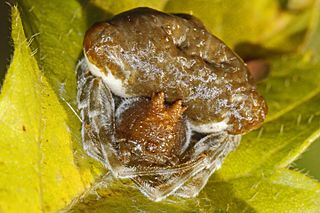
Mastophora phrynosoma is a species of orb weaver in the spider family Araneidae. It is found in the United States. Like all known species of the genus Mastophora, adult females are bolas spiders, capturing their prey with one or more sticky drops at the end of a single line of silk rather than in a web. Males and juvenile females capture their prey directly with their legs.

Scytodes fusca, the brown spitting spider, is a species of spitting spider in the family Scytodidae. It is found in Central and Southern America, has been introduced into Europe, tropical Africa, Seychelles, Myanmar, China, Japan, and Hawaii.

Phidippus comatus is a species of jumping spider in the family Salticidae. It is found in North America.
Yunohamella yunohamensis is a species of comb-footed spider in the family Theridiidae. The species inhabits the far east of Russia, Korea, and Japan.
Yunohamella gibbosa is a species of comb-footed spider in the family Theridiidae. It is found in China.

















